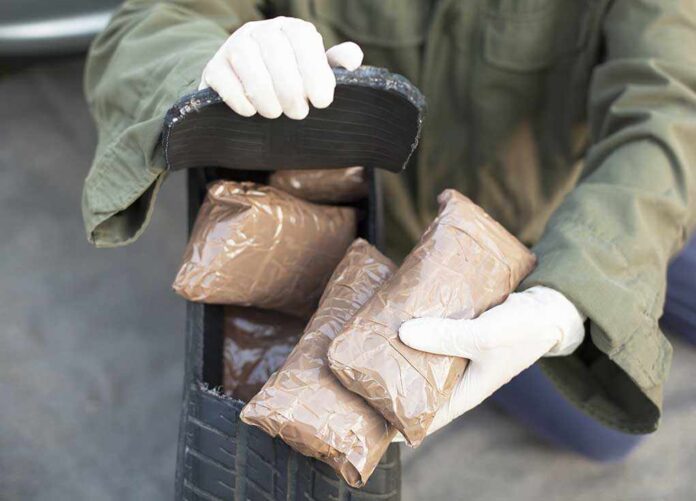A sophisticated 3,000-foot narcotics tunnel featuring electrical wiring, ventilation, and rail systems was discovered connecting Tijuana to San Diego, highlighting the dangerous evolution of cartel smuggling operations at our southern border.
Key Takeaways
- U.S. Border Patrol agents uncovered an unfinished but sophisticated 2,918-foot narcotics smuggling tunnel reaching from Tijuana to underneath the Otay Mesa Port of Entry
- The tunnel featured advanced infrastructure including electrical wiring, lighting, ventilation, and a rail system designed for transporting drugs
- Mexican authorities discovered the tunnel originated from a home in Nueva Tijuana, cleverly concealed beneath freshly laid tiles
- Over 95 similar tunnels have been discovered and decommissioned in the San Diego area since 1993, showing cartels’ persistent efforts to bypass border security
- Border officials plan to fill the tunnel with thousands of pounds of concrete to permanently prevent its use
Sophisticated Underground Infrastructure Reveals Cartel Ingenuity
The tunnel, discovered in early April by the San Diego Sector Tunnel Team, extends a staggering 2,918 feet from Tijuana to underneath the Otay Mesa Port of Entry. The underground passageway was found approximately 50 feet below ground level, measuring nearly 40 inches in height and 30 inches in width. Despite being unfinished, the tunnel already featured sophisticated infrastructure that would make professional mining operations envious of complete electrical wiring, lighting systems, ventilation to ensure breathable air, and even a rail system designed specifically for transporting contraband across the international border.
Mexican authorities, working in cooperation with U.S. law enforcement, traced the tunnel’s origin to a residence in Nueva Tijuana where smugglers had cleverly concealed the entrance beneath freshly laid tiles. The tunnel’s planned exit point in the United States was targeting a nearby commercial warehouse space, strategically positioned to facilitate the unloading and distribution of narcotics. Tunnel workers had even installed makeshift barricades within the passageway, designed to hinder law enforcement’s progress and conceal the tunnel’s origin point from authorities.
Strategic Location Selection Reveals Cartel Planning
The location of this tunnel wasn’t chosen by chance. According to experts, the area provides multiple advantages for illicit underground operations. “The type of soil, the urban noise, traffic in the area, we have a port of entry where not only vehicles cross daily, thousands of them, pedestrians, and also trucks cross to the U.S,” said Victor Clark, a security expert familiar with cartel operations.
The tunnel’s placement near both the Otay Mesa Port of Entry and an international airport provides ideal conditions for smuggling operations. The constant background noise from heavy traffic and commercial activity helps mask excavation sounds, while the urban environment offers anonymity. The discovery continues a troubling pattern, as over 95 similar tunnels have been found and decommissioned in the San Diego area since 1993, highlighting how cartels continue adapting their smuggling methods despite enhanced border security measures implemented during the Trump administration.
Evolving Cartel Tactics in Response to Border Enforcement
While tunnels have been a staple of cartel smuggling operations for decades, experts note that their construction has grown increasingly sophisticated since the early 2000s. These engineering marvels can cost cartels between $1-4 million to construct, reflecting the immense profits generated through narcotics trafficking. In recent years, however, cartels have shifted toward smuggling smaller quantities of high-value substances like fentanyl through legal ports of entry, making elaborate tunnels less economically attractive for day-to-day operations.
U.S. Border Patrol agents say they uncovered and disabled a large-scale drug smuggling tunnel leading to San Diego from Tijuana. And, raising a flag to celebrate Juneteenth. Plus: The Hotel Del Coronado's 6-year, $550 million makeover is complete. https://t.co/DYxYWjfIto
— NBC 7 San Diego (@nbcsandiego) June 19, 2025
“As we continue to strengthen the nation’s air and maritime border security, it’s not surprising that foreign terrorist organizations would resort to underground routes. Disruption of narcotics smuggling tunnels is critical to protecting American lives,” said Jeffrey D. Stalnaker, Acting Chief Patrol Agent of the San Diego Sector.
DEA officials suggest that increased pressure on smugglers at ports of entry may be driving cartels back to tunnel construction as a viable alternative. U.S. Customs and Border Protection (CBP) plans to permanently neutralize this particular tunnel by filling it with thousands of pounds of concrete, rendering it unusable for future smuggling attempts. However, the discovery raises serious questions about how many similar tunnels might remain undetected beneath our southern border, continuously funneling dangerous narcotics into American communities.











